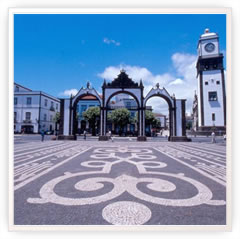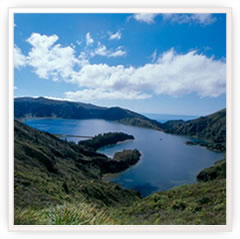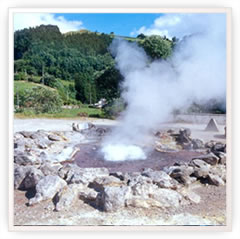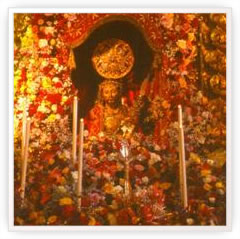São Miguel Island




HISTORY
The first settlement was founded in 1444, after Prince Henry ordered cattle to be sent to seven of the islands in the archipelago. Gonçalo Velho, a knight and friar of the Order of Christ,was appointed to the Captaincy. The first settlers came from the provinces of Estremadura, the Upper Alentejo and the Algarve and were later joined by Madeirans, Jews, Moors and possibly the French (as evidenced in the name of the parish of Bretanha).
The fertile soil and the island's location midway between Europe, Africa and America contributed towards its rapidly expanding economy, based on the cultivation of wheat (exported to the Portuguese garrisons of the North African strongholds), sugar cane, woad and orchil for dyeing (exported to Flanders), wine and dairy products. A century later, sweet potatoes, maize, yams, flax and oranges were added to the island's production.
Attacked by French, English and Algerian pirates in the late 16th century and part of the 17th century, São Miguel was occupied by Spanish troops in 1582 after the defeat, off Vila Franca do Campo, of a French fleet in which Portuguese troops also fought, which was aiding D. António, Prior of Crato, the pretender to the Portuguese throne. After the Restoration in 1640, São Miguel recovered its position as a trading centre and forged links with Brazil, leading to the establishment of emigrant settlements there.
From the end of the 17th century, the export of oranges to England brought great prosperity to the island.
A disease which first appeared in 1860 destroyed the orange trees but the initiative of the local population soon ensured that these were replaced with new plantations - tobacco, tea, bulrush, chicory, sugar-beet and pineapples - which guaranteed economic survival and were supplemented over the years by a range of industries and the expansion of fishing and livestock.
Nowadays São Miguel, a regional administrative and political decision-making centre, is an island with a diversified economy that is making clear progress.
GEOGRAPHY
São Miguel, which is the largest island in the Azores archipelago, has an area of 759.41 km2. It is 65 km long and 16 km at its widest point. S. Miguel island is composed of two volcanic massifs separated by a low central ridge. The highest point is at Pico da Vara in the eastern massif, which rises to 1080 m. The large craters of Sete Cidades, Fogo and Furnas contain wonderful lakes of crystal-clear water.
The island is located at longitude 25°30’ west and latitude 37°50’ north.
GASTRONOMY
Fish stew
"Cozido das Furnas" (casserole)
Seafood
Pineapple
Cheeses
Liqueurs
Tea
"Bolo Lêvedo" (yeast cake)
FESTIVALS
THE HOLY SPIRIT FESTIVAL
This festival is celebrated on all the islands although it varies in detail from one to another and even within different areas of the islands themselves. All the parishes in each island have a chapel, known as an "Império" (empire), with its own brotherhood. These are considered the most typical in the islands'' tradition of religious festivals.
Place: Throughout the archipelago
Date: May to September and in particular the 7th Sunday after Easter
Event organisation: The Holy Spirit Brotherhoods
THE "SENHOR SANTO CRISTO DOS MILAGRES" FESTIVITIES
Held every year on the Island of S. Miguel on the fifth Sunday after Easter, the festival lasts three days, during which time the image of "Senhor Santo Cristo" is worshipped at Esperança Convent in Ponta Delgada as part of tradition that dates back over 400 years. In addition to the religious aspects of the festival, there are also sporting and cultural events.
Place: Ponta Delgada, Island of S. Miguel
Date: 5th Sunday after Easter
Event organisation: The Brotherhood of "Senhor Santo Cristo dos Milagres"
"CAVALHADAS DE S. PEDRO"
The Cavalhadas de S. Pedro takes place every year in Ribeira Grande. The "King", or "Head", knights, lancers, stewards and trumpeters dressed in colourful costumes parade through the streets on their shining horses on the morning of St. Peter's day.
Place: The parish of Ribeira Seca in the municipality of Ribeira Grande on the Island of S. Miguel
Date: 29 June
Event organisation: Festival committee
PLACES TO VISIT
"LAGOA DAS SETE CIDADES" (LAKE)
On the extreme east of the Island of S. Miguel the emerald green and deep blue of this lake recalls countless legends of the Seven Bishops and Seven Cities consumed by the flames of the Seven Volcanoes.
"LAGOA DO FOGO" (LAKE)
In the centre of the Island of S. Miguel, sloping down on a carpet of soft fields to a dazzling white sandy beach lies an enormous crater, flanked by the deep blue sea to the north and the brilliant sunlight of the south, and concealing the long oval-shaped "Lagoa do Fogo".
FURNAS
A universal hydropolis with a lake intersected by gardens and forests reminiscent of childhood fairy tales, filled with flowers, lots of flowers, and water - mineral waters, thermal waters, waters recommended for every ailment to revive and soothe the soul.
NORDESTE
The eastern kingdom of Pico da Vara, where the "north-east" is the least well-known but possibly the best-preserved, most colourful and delightful part of the island.
"VILA FRANCA" ISLET
A Nature Reserve near Vila Franca do Campo which extends along approximately 1 km of coast. Regular transport for visitors, particularly in the summer season.
